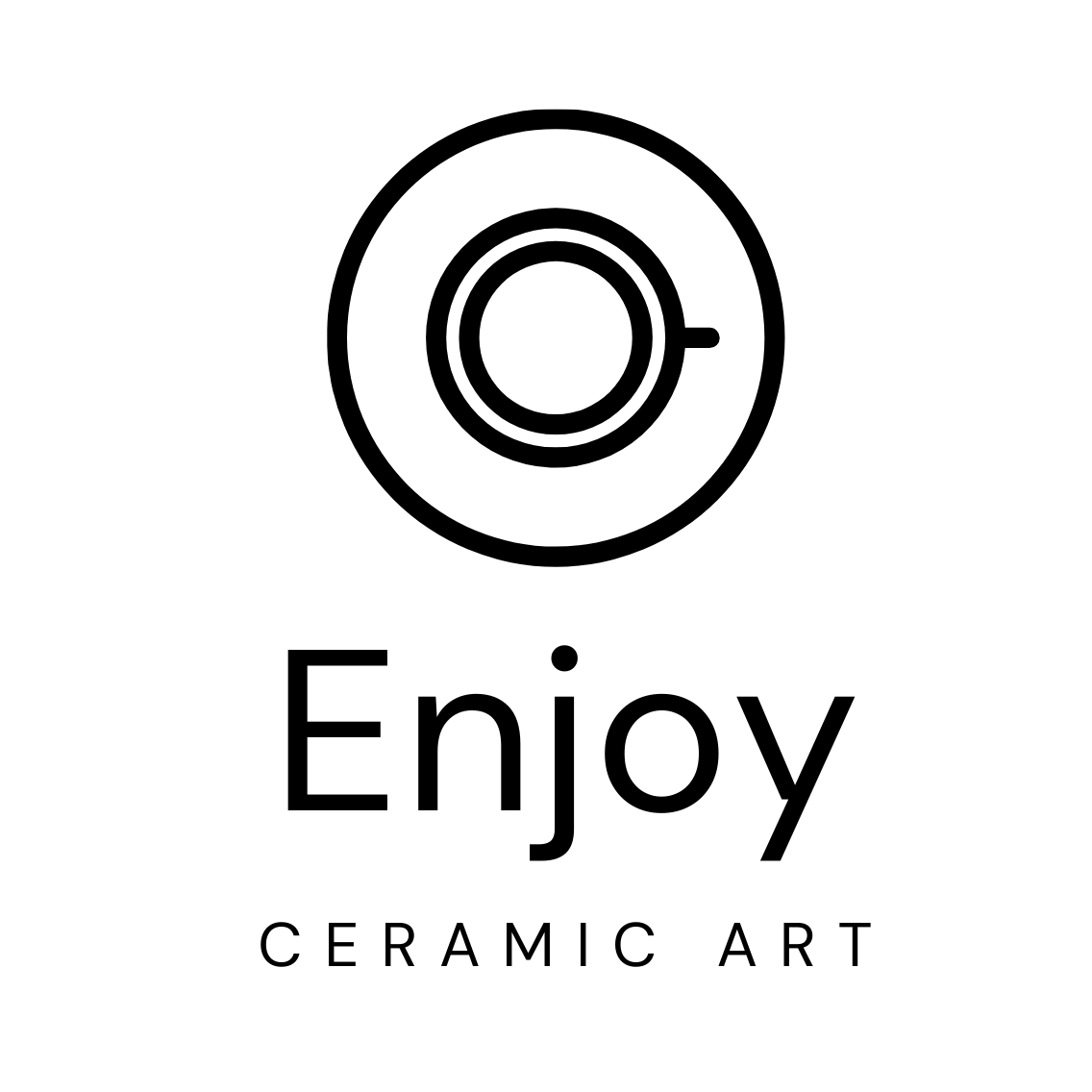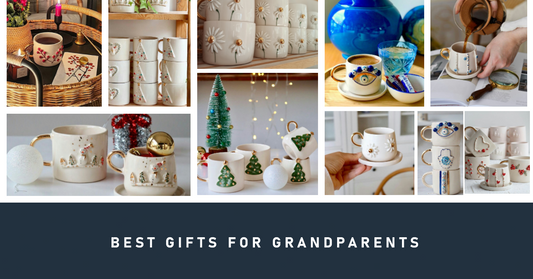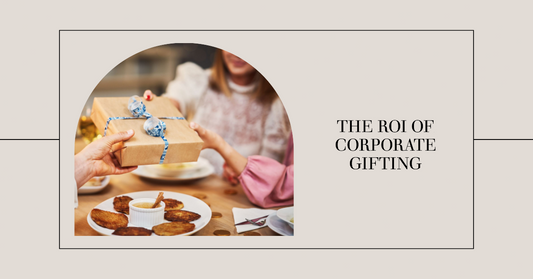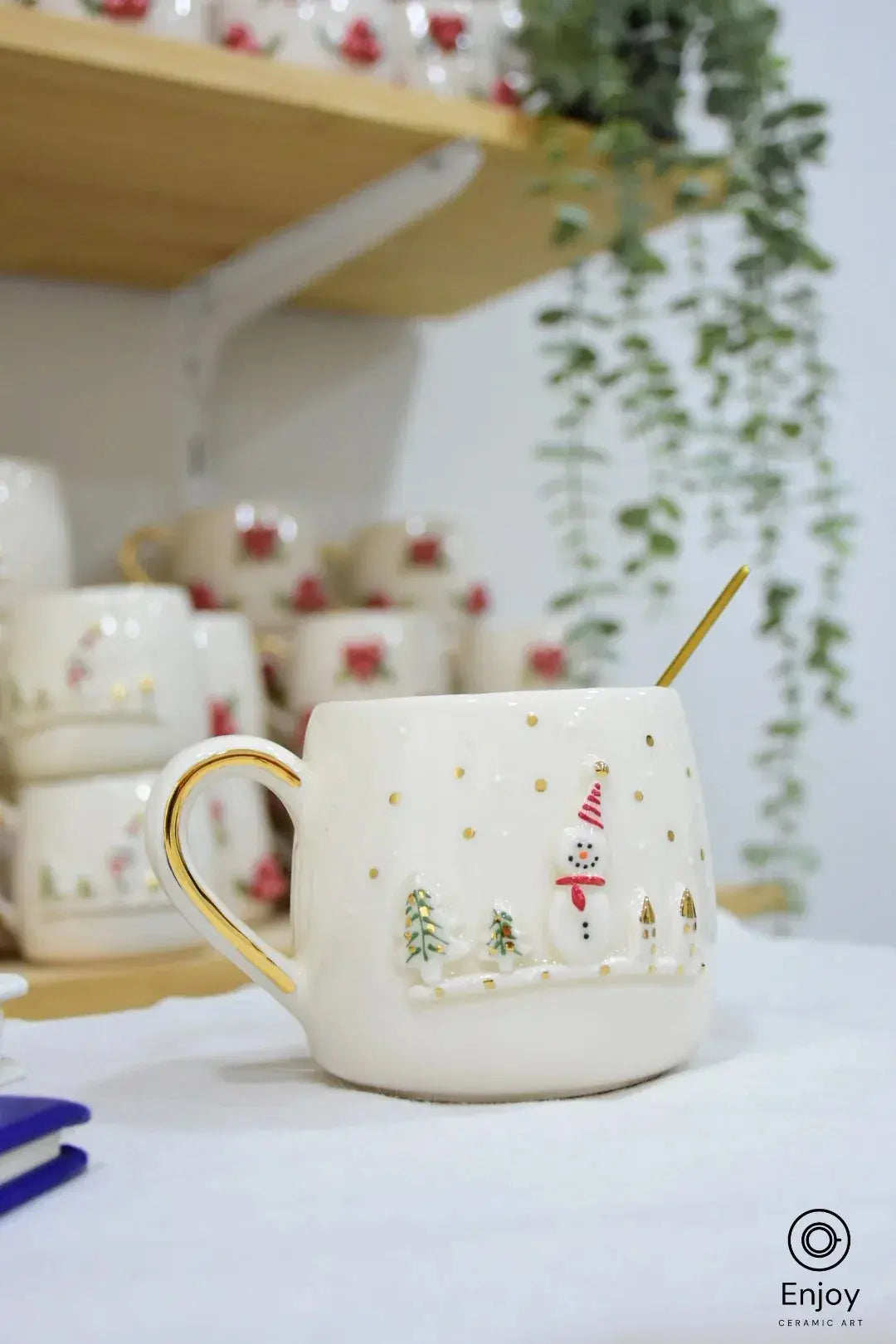جدول المحتويات
مقدمة:
تعتبر العلامة التجارية عنصرا أساسيا في استراتيجية التسويق لأي شركة.
إنه يشمل الجوانب البصرية والعاطفية التي تشكل كيفية إدراك الجمهور المستهدف للأعمال التجارية.
يمكن لاستراتيجية العلامة التجارية القوية أن تخلق انطباعًا دائمًا ، وتبني ولاء العملاء، وتميز الشركة عن منافسيها.
من الأدوات القوية التي غالبًا ما يتم التغاضي عنها في العلامات التجارية هي السيراميك المخصص .
من أكواب القهوة إلى أكواب الإسبريسو ، يمكن لهذه القطع الفريدة والمصنوعة يدويًا أن تضيف لمسة من الأناقة والشخصية والحصرية إلى جهود العلامة التجارية للشركة.
في هذه المقالة، سوف نستكشف خمس طرق لدمج السيراميك المخصص في استراتيجية العلامة التجارية لشركتك، مع التركيز على الاستمتاع بمجموعات Ceramic Art الرائعة من أكواب القهوة وأكواب الإسبريسو.
المجالات الخمسة الرئيسية لاستراتيجية العلامة التجارية:

- الهوية البصرية: العناصر البصرية للعلامة التجارية، مثل الشعار والألوان والخطوط والصور، تخلق الانطباع الأول وتنقل شخصية وقيم الشركة. يمكن استخدام السيراميك المخصص لتوسيع وتعزيز الهوية البصرية للعلامة التجارية. على سبيل المثال، من خلال عرض شعار الشركة أو ألوان العلامة التجارية على أكواب القهوة أو أكواب الإسبريسو ، يمكن للشركات إنشاء صورة علامة تجارية متسقة ولا تُنسى تترك انطباعًا دائمًا لدى العملاء.
- التغليف والعرض: يمكن أن يلعب تغليف المنتجات وعرضها دورًا مهمًا أيضًا في بناء العلامة التجارية. يمكن استخدام السيراميك المخصص لإنشاء حلول تغليف فريدة وجذابة لأكواب القهوة وأكواب الإسبريسو. على سبيل المثال، يمكن أن يؤدي استخدام صناديق الهدايا المصنوعة من السيراميك أو تغليف الأكواب في ورق مناديل يحمل العلامة التجارية إلى الارتقاء بتجربة فتح العلب للعملاء، وإضافة لمسة من الفخامة والرقي إلى العلامة التجارية.
- رواية القصص: تعتبر رواية القصص أداة قوية لبناء العلامة التجارية تتيح للشركات التواصل مع جمهورها على المستوى العاطفي. يمكن استخدام السيراميك المخصص لسرد قصة العلامة التجارية من خلال تصميمات وموضوعات فريدة. على سبيل المثال، يمكن استخدام مجموعات Enjoy Ceramic Art من أكواب الكريسماس ، والأكواب الزرقاء والذهبية ، والأكواب الزهرية ، وأكواب الخريف والهالوين لإنشاء قصة موسمية تتردد صداها لدى العملاء وتضيف عمقًا لشخصية العلامة التجارية.
- الهدايا للشركات: تعتبر الهدايا للشركات اتجاهًا شائعًا في عالم الأعمال، حيث إنها تسمح للشركات بالتعبير عن الامتنان وتعزيز العلاقات والترويج لعلامتها التجارية. يمكن استخدام السيراميك المخصص كهدايا للشركات رائعة ومدروسة. على سبيل المثال، يمكن تخصيص أكواب وأكواب Enjoy Ceramic Art المصنوعة يدويًا برسالة خاصة، مما يجعلها هدايا فريدة لا تُنسى تترك انطباعًا دائمًا لدى المتلقين.
- التعاون مع العلامات التجارية: يمكن أن يكون التعاون مع العلامات التجارية الأخرى أو الفنانين طريقة إبداعية لتوسيع جهود الشركة في بناء العلامة التجارية. يمكن استخدام السيراميك المخصص كلوحة للتعاون مع الفنانين أو المصممين أو الشركات الأخرى. على سبيل المثال، يمكن لشركة Enjoy Ceramic Art التعاون مع الفنانين المحليين لإنشاء أكواب قهوة أو أكواب إسبريسو محدودة الإصدار تتميز بأعمال فنية أو تصاميم فريدة، مما يخلق شعورًا بالحصرية والإبداع يميز العلامة التجارية عن المنافسين.
إنشاء تصميمات هوية العلامة التجارية: 5 خطوات لتحقيق النجاح

بمجرد تحديد استراتيجية علامتك التجارية، فإن الخطوة التالية هي إنشاء تصميمات لهوية العلامة التجارية تعكس جوهر علامتك التجارية وتنقل رسالة علامتك التجارية إلى جمهورك المستهدف بشكل فعال.
فيما يلي خمس خطوات لإنشاء تصميمات هوية العلامة التجارية التي ستساعد علامتك التجارية على التميز:
- حدد العناصر المرئية لعلامتك التجارية: تلعب العناصر المرئية لعلامتك التجارية، مثل الشعار ولوحة الألوان والطباعة والصور، دورًا حاسمًا في إنشاء هوية علامة تجارية متسقة لا تُنسى. ابدأ بتحديد الألوان الأساسية والثانوية لعلامتك التجارية، واختيار الخط الذي يمثل شخصية علامتك التجارية، وتصميم شعار يجسد جوهر علامتك التجارية. ضع في اعتبارك التأثير العاطفي الذي ستخلفه العناصر المرئية على جمهورك المستهدف وتأكد من أنها تتماشى مع استراتيجية علامتك التجارية الشاملة.
- تطوير إرشادات العلامة التجارية: تعمل إرشادات العلامة التجارية كخريطة طريق لاستخدام العناصر المرئية لعلامتك التجارية بشكل متسق عبر جميع نقاط الاتصال. يجب أن تتضمن هذه الإرشادات قواعد لاستخدام الشعار ولوحة الألوان والطباعة والصور والعناصر المرئية الأخرى، بالإضافة إلى إرشادات لنبرة الصوت والرسائل. من خلال وضع إرشادات واضحة للعلامة التجارية، فإنك تضمن أن تظل هوية علامتك التجارية متسقة ومتماسكة، بغض النظر عن المنصة أو الوسيلة.
- إنشاء مواد دعائية تحمل علامتك التجارية: تشير المواد الدعائية التي تحمل علامتك التجارية إلى أي مواد أو أصول تتميز بهوية علامتك التجارية وتُستخدم لأغراض الاتصال والترويج. ويشمل ذلك بطاقات العمل، والخطابات الرسمية، وتوقيعات البريد الإلكتروني، والرسومات الخاصة بوسائل التواصل الاجتماعي، وتصميم مواقع الويب، والتغليف. عند إنشاء مواد دعائية تحمل علامتك التجارية، تأكد من أنها تتوافق مع العناصر المرئية لعلامتك التجارية وتتبع إرشادات علامتك التجارية. يعزز هذا الاتساق هوية علامتك التجارية ويجعلها أكثر تميزًا لجمهورك المستهدف.
- دمج تصميمات هوية العلامة التجارية عبر جميع نقاط الاتصال: لإنشاء هوية علامة تجارية متماسكة وفعالة، من الضروري دمج العناصر المرئية لعلامتك التجارية عبر جميع نقاط الاتصال حيث تتفاعل علامتك التجارية مع جمهورك المستهدف. ويشمل ذلك موقع الويب الخاص بك، وملفات التعريف على وسائل التواصل الاجتماعي، والتغليف، والمواد الترويجية، والحملات الإعلانية، وأي نقاط اتصال أخرى ذات صلة بجمهورك المستهدف. يؤدي الاتساق في تصميمات هوية علامتك التجارية عبر جميع نقاط الاتصال إلى خلق التعرف على العلامة التجارية وبناء الثقة مع جمهورك.
- الاختبار والتكرار: بمجرد تنفيذ تصميمات هوية علامتك التجارية، من المهم اختبار فعاليتها وإجراء التكرارات اللازمة بناءً على الملاحظات والنتائج. راقب أداء تصميمات هوية علامتك التجارية عبر نقاط اتصال مختلفة وجمع الملاحظات من جمهورك المستهدف للتأكد من أن علامتك التجارية تلقى صدى لديهم. إذا لزم الأمر، قم بإجراء تعديلات على تصميمات هوية علامتك التجارية لتتوافق بشكل أفضل مع استراتيجية علامتك التجارية وتفضيلات الجمهور المستهدف.
استراتيجيات مفيدة لبناء علامتك التجارية الشخصية: 5 خطوات أساسية

في مشهد الأعمال التنافسي اليوم، أصبح بناء علامة تجارية شخصية قوية أمرًا مهمًا بشكل متزايد للمحترفين ورجال الأعمال على حد سواء.
علامتك التجارية الشخصية هي الطريقة التي تقدم بها نفسك للآخرين وتميز نفسك عن المنافسة.
فيما يلي خمس استراتيجيات مفيدة لبناء علامتك التجارية الشخصية:
- حدد استراتيجية علامتك التجارية الشخصية: تشكل استراتيجية علامتك التجارية الشخصية الأساس لعلامتك التجارية الشخصية. وهي تتضمن تحديد نقاط قوتك الفريدة وقيمك وشغفك، وتحديد الطريقة التي تريد أن ينظر إليك بها الآخرون. ابدأ بتحديد جمهورك المستهدف وفهم احتياجاتهم وتفضيلاتهم. ثم قم بصياغة رسالة واضحة ومقنعة للعلامة التجارية الشخصية تنقل عرض القيمة الخاص بك وتميزك عن الآخرين في مجالك.
- قم بتأسيس حضورك على الإنترنت: في العصر الرقمي الحالي، يعد وجود حضور قوي على الإنترنت أمرًا ضروريًا لبناء علامة تجارية شخصية. قم بإنشاء موقع ويب أو مدونة احترافية تعرض خبرتك وإنجازاتك ومحفظتك. قم بتحسين ملفاتك الشخصية على وسائل التواصل الاجتماعي لتعكس استراتيجية علامتك التجارية الشخصية ومشاركة محتوى قيم يتردد صداه لدى جمهورك المستهدف. تواصل باستمرار مع جمهورك وأثبت نفسك كخبير في مجالك.
- التواصل بشكل استراتيجي: يعد التواصل أداة قوية لبناء علامتك التجارية الشخصية. احضر الفعاليات الصناعية، وانضم إلى الجمعيات المهنية، وشارك في المجتمعات عبر الإنترنت ذات الصلة بمجالك. قم بالتواصل بشكل استراتيجي من خلال التواصل مع الأفراد الذين يمكنهم مساعدتك في توسيع نطاق وصولك ونفوذك في صناعتك. قم ببناء علاقات ذات مغزى مع أصحاب المصلحة الرئيسيين والموجهين والمؤثرين الذين يمكنهم تأييد علامتك التجارية الشخصية والترويج لها.
- إظهار الخبرة من خلال إنشاء المحتوى: إن إنشاء محتوى قيم ومشاركته يعد وسيلة فعالة لإظهار خبرتك وإثبات نفسك كقائد فكري في مجالك. ابدأ مدونة أو اكتب مقالات أو أنشئ مقاطع فيديو أو استضف بودكاست يعرض معرفتك ورؤيتك. شارك المحتوى الخاص بك على موقع الويب الخاص بك ووسائل التواصل الاجتماعي ومنصات الصناعة ذات الصلة لعرض خبرتك وتقديم قيمة لجمهورك.
- حافظ على علامتك التجارية الشخصية باستمرار: إن بناء علامة تجارية شخصية هو عملية مستمرة تتطلب الاتساق والأصالة. كن صادقًا مع نفسك وحافظ باستمرار على رسالة علامتك التجارية الشخصية عبر جميع نقاط الاتصال، بما في ذلك تواجدك على الإنترنت وفعاليات التواصل والمشاركات في المحاضرات والتفاعلات المهنية. كن حريصًا على الطريقة التي تقدم بها نفسك وتأكد من أنها تتوافق مع استراتيجية وقيم علامتك التجارية الشخصية.
وفي الختام، يتطلب بناء علامة تجارية شخصية قوية نهجًا استراتيجيًا يتضمن تحديد استراتيجية علامتك التجارية الشخصية، وإنشاء حضورك عبر الإنترنت، والتواصل بشكل استراتيجي، وإظهار الخبرة من خلال إنشاء المحتوى، والحفاظ على علامتك التجارية الشخصية باستمرار.
من خلال اتباع هذه الخطوات، يمكنك إنشاء علامة تجارية شخصية مميزة تساعدك على تحقيق أهدافك المهنية.







